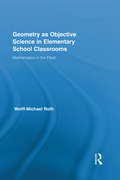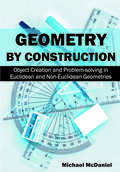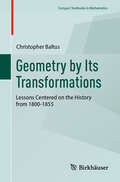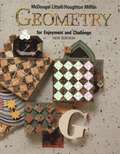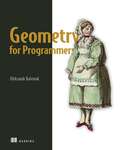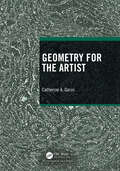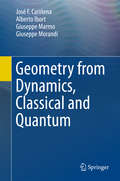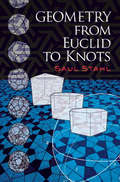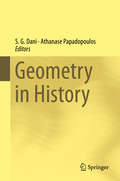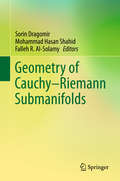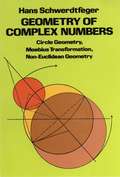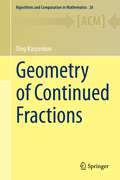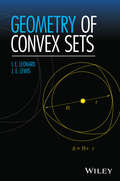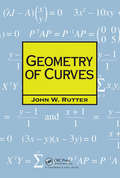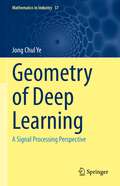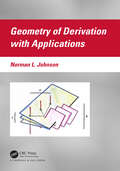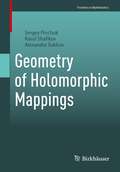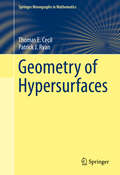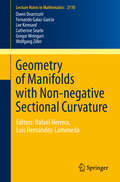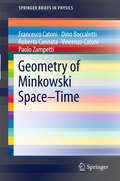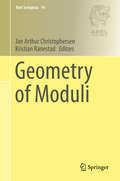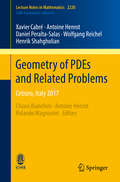- Table View
- List View
Geometry as Objective Science in Elementary School Classrooms: Mathematics in the Flesh (Routledge International Studies in the Philosophy of Education)
by Wolff-Michael RothThis study examines the origins of geometry in and out of the intuitively given everyday lifeworlds of children in a second-grade mathematics class. These lifeworlds, though pre-geometric, are not without model objects that denote and come to anchor geometric idealities that they will understand at later points in their lives. Roth's analyses explain how geometry, an objective science, arises anew from the pre-scientific but nevertheless methodic actions of children in a structured world always already shot through with significations. He presents a way of understanding knowing and learning in mathematics that differs from other current approaches, using case studies to demonstrate contradictions and incongruences of other theories – Immanuel Kant, Jean Piaget, and more recent forms of (radical, social) constructivism, embodiment theories, and enactivism – and to show how material phenomenology fused with phenomenological sociology provides answers to the problems that these other paradigms do not answer.
Geometry by Construction: Object Creation and Problem-Solving in Euclidean and Non-Euclidean Geometries
by Michael McDanielCollege geometry students, professors interested in undergraduate research and secondary geometry teachers will find three rich environments in this textbook. The first chapter contains many of the standards of Euclidean college geometry. The second and third chapters introduce non-Euclidean models where some Euclidean rules hold and others do not. With emphases on constructions and proofs, the reader is encouraged to create the objects under investigation and verify the results with reasoning. Since both models of “bent” spaces exist in Euclidean geometry, the reader gains facility with Euclidean moves through the whole book, even while exploring non-Euclidean spaces. The book itself is meant to be unpacked, expanded and taken further, just like the problems it contains. Geometry by Construction challenges its readers to participate in the creation of mathematics. The questions span the spectrum from easy to newly-published research and so are appropriate for a variety of students and teachers. From differentiation in a high school course through college classes and into summer research, any interested geometer will find compelling material. Teachers and professors might especially appreciate the way constructions provide open-ended questions which resist internet searches for solutions. College students should find the five refereed results from undergraduates like themselves encouraging. The active reader joins the mathematical tradition of a laboratory being a notebook plus a compass and ruler (or a dynamic geometry program on a computer.) New ideas await exploration and here are examples!
Geometry by Its Transformations: Lessons Centered on the History from 1800-1855 (Compact Textbooks in Mathematics)
by Christopher BaltusThis textbook combines the history of synthetic geometry, centered on the years 1800-1855, with a theorem-proof exposition of the geometry developed in those years. The book starts with the background needed from Euclid’s Elements, followed by chapters on transformations, including dilation (similitude), homology, homogeneous coordinates, projective geometry, inversion, the Möbius transformation, and transformation geometry as in French schoolbooks of 1910. Projective geometry is presented by tracing its path through the work of J. V. Poncelet, J. Steiner, and K. G. C. von Staudt. Extensive exercises are included, many from the period studied. The prerequisites for approaching this course are knowledge of high school geometry and enthusiasm for mathematical demonstration. This textbook is ideal for a college geometry course, for self-study, or as preparation for the study of modern geometry.
Geometry for Enjoyment and Challenge (New Edition)
by Robert Whipple George Milauskas Richard RhoadGeometry for Enjoyment and Challenge has been authored to make geometry fun, exciting, and powerful.
Geometry for Programmers
by Oleksandr KaleniukMaster the math behind CAD, game engines, GIS, and more! This hands-on book teaches you the geometry used to create simulations, 3D prints, and other models of the physical world.In Geometry for Programmers you will learn how to: Speak the language of applied geometry Compose geometric transformations economically Craft custom splines for efficient curves and surface generation Pick and implement the right geometric transformations Confidently use important algorithms that operate on triangle meshes, distance functions, and voxels Geometry for Programmers guides you through the math behind graphics and modeling tools. It&’s full of practical examples and clear explanations that make sense even if you don&’t have a background in advanced math. You&’ll learn how basic geometry can help you avoid code layering and repetition, and even how to drive down cloud hosting costs with more efficient runtimes. Cheerful language, charts, illustrations, equations, and Python code help make geometry instantly relevant to your daily work as a developer. About the Technology Geometry is at the heart of game engines, robotics, computer-aided design, GIS, and image processing. This book draws back what is for some a mathematical curtain, giving them insight and control over this central tool. You&’ll quickly see how a little geometry can help you design realistic simulations, translate the physical world into code, and even reduce your cloud services bill by improving the efficiency of graphics-intensive applications. About the Book Geometry for Programmers is both practical and entertaining. Fun illustrations and engaging examples show you how to apply geometry to real programming problems, like changing a scan into a CAD model or developing 3D printing contours from a parametric function. And don&’t worry if you aren&’t a math expert. There&’s no heavy theory, and you&’ll learn how to offload most equations to the SymPy computer algebra system. What&’s Inside Speak the language of applied geometry Compose geometric transformations economically Craft custom splines for efficient curves and surface generation Confidently use geometry algorithms About the Reader Examples are in Python, and all you need is high school–level math. About the Author Oleksandr Kaleniuk is the creator of Words and Buttons Online, a collection of interactive tutorials on math and programming. Table of Contents 1 Getting started 2 Terminology and jargon 3 The geometry of linear equations 4 Projective geometric transformations 5 The geometry of calculus 6 Polynomial approximation and interpolation 7 Splines 8 Nonlinear transformations and surfaces 9 The geometry of vector algebra 10 Modeling shapes with signed distance functions and surrogates 11 Modeling surfaces with boundary representations and triangle meshes 12 Modeling bodies with images and voxels
Geometry for the Artist
by Catherine A. GoriniGeometry for the Artist is based on a course of the same name which started in the 1980s at Maharishi International University. It is aimed both at artists willing to dive deeper into geometry and at mathematicians open to learning about applications of mathematics in art. The book includes topics such as perspective, symmetry, topology, fractals, curves, surfaces, and more. A key part of the book’s approach is the analysis of art from a geometric point of view—looking at examples of how artists use each new topic. In addition, exercises encourage students to experiment in their own work with the new ideas presented in each chapter. This book is an exceptional resource for students in a general-education mathematics course or teacher-education geometry course, and since many assignments involve writing about art, this text is ideal for a writing-intensive course. Moreover, this book will be enjoyed by anyone with an interest in connections between mathematics and art. Features Abundant examples of artwork displayed in full color Suitable as a textbook for a general-education mathematics course or teacher-education geometry course Designed to be enjoyed by both artists and mathematicians
Geometry from Dynamics, Classical and Quantum
by Giuseppe Marmo José F. Cariñena Alberto Ibort Giuseppe MorandiThis book describes, by using elementary techniques, how some geometrical structures widely used today in many areas of physics, like symplectic, Poisson, Lagrangian, Hermitian, etc. , emerge from dynamics. It is assumed that what can be accessed in actual experiences when studying a given system is just its dynamical behavior that is described by using a family of variables ("observables" of the system). The book departs from the principle that ''dynamics is first'' and then tries to answer in what sense the sole dynamics determines the geometrical structures that have proved so useful to describe the dynamics in so many important instances. In this vein it is shown that most of the geometrical structures that are used in the standard presentations of classical dynamics (Jacobi, Poisson, symplectic, Hamiltonian, Lagrangian) are determined, though in general not uniquely, by the dynamics alone. The same program is accomplished for the geometrical structures relevant to describe quantum dynamics. Finally, it is shown that further properties that allow the explicit description of the dynamics of certain dynamical systems, like integrability and super integrability, are deeply related to the previous development and will be covered in the last part of the book. The mathematical framework used to present the previous program is kept to an elementary level throughout the text, indicating where more advanced notions will be needed to proceed further. A family of relevant examples is discussed at length and the necessary ideas from geometry are elaborated along the text. However no effort is made to present an ''all-inclusive'' introduction to differential geometry as many other books already exist on the market doing exactly that However, the development of the previous program, considered as the posing and solution of a generalized inverse problem for geometry, leads to new ways of thinking and relating some of the most conspicuous geometrical structures appearing in Mathematical and Theoretical Physics.
Geometry from Euclid to Knots: From Euclid To Knots (Dover Books on Mathematics)
by Saul StahlDesigned to inform readers about the formal development of Euclidean geometry and to prepare prospective high school mathematics instructors to teach Euclidean geometry, this text closely follows Euclid's classic, Elements. The text augments Euclid's statements with appropriate historical commentary and many exercises -- more than 1,000 practice exercises provide readers with hands-on experience in solving geometrical problems. In addition to providing a historical perspective on plane geometry, this text covers non-Euclidean geometries, allowing students to cultivate an appreciation of axiomatic systems. Additional topics include circles and regular polygons, projective geometry, symmetries, inversions, knots and links, graphs, surfaces, and informal topology. This republication of a popular text is substantially less expensive than prior editions and offers a new Preface by the author.
Geometry from a Differentiable Viewpoint
by John McclearyThe development of geometry from Euclid to Euler to Lobachevsky, Bolyai, Gauss, and Riemann is a story that is often broken into parts - axiomatic geometry, non-Euclidean geometry, and differential geometry. This poses a problem for undergraduates: Which part is geometry? What is the big picture to which these parts belong? In this introduction to differential geometry, the parts are united with all of their interrelations, motivated by the history of the parallel postulate. Beginning with the ancient sources, the author first explores synthetic methods in Euclidean and non-Euclidean geometry and then introduces differential geometry in its classical formulation, leading to the modern formulation on manifolds such as space-time. The presentation is enlivened by historical diversions such as Hugyens's clock and the mathematics of cartography. The intertwined approaches will help undergraduates understand the role of elementary ideas in the more general, differential setting. This thoroughly revised second edition includes numerous new exercises and a new solution key. New topics include Clairaut's relation for geodesics, Euclid's geometry of space, further properties of cycloids and map projections, and the use of transformations such as the reflections of the Beltrami disk.
Geometry in History
by Athanase Papadopoulos S. G. DaniThis is a collection of surveys on important mathematical ideas, their origin, their evolution and their impact in current research. The authors are mathematicians who are leading experts in their fields. The book is addressed to all mathematicians, from undergraduate students to senior researchers, regardless of the specialty.
Geometry in a Fréchet Context: A Projective Limit Approach
by C. T. J. Dodson George Galanis Efstathios VassiliouMany geometrical features of manifolds and fibre bundles modelled on Fréchet spaces either cannot be defined or are difficult to handle directly. This is due to the inherent deficiencies of Fréchet spaces; for example, the lack of a general solvability theory for differential equations, the non-existence of a reasonable Lie group structure on the general linear group of a Fréchet space, and the non-existence of an exponential map in a Fréchet-Lie group. In this book, the authors describe in detail a new approach that overcomes many of these limitations by using projective limits of geometrical objects modelled on Banach spaces. It will appeal to researchers and graduate students from a variety of backgrounds with an interest in infinite-dimensional geometry. The book concludes with an appendix outlining potential applications and motivating future research.
Geometry of Cauchy-Riemann Submanifolds
by Sorin Dragomir Mohammad Hasan Shahid Falleh R. Al-SolamyThis book gathers contributions by respected experts on the theory of isometric immersions between Riemannian manifolds, and focuses on the geometry of CR structures on submanifolds in Hermitian manifolds. CR structures are a bundle theoretic recast of the tangential Cauchy-Riemann equations in complex analysis involving several complex variables. The book covers a wide range of topics such as Sasakian geometry, Kaehler and locally conformal Kaehler geometry, the tangential CR equations, Lorentzian geometry, holomorphic statistical manifolds, and paraquaternionic CR submanifolds. Intended as a tribute to Professor Aurel Bejancu, who discovered the notion of a CR submanifold of a Hermitian manifold in 1978, the book provides an up-to-date overview of several topics in the geometry of CR submanifolds. Presenting detailed information on the most recent advances in the area, it represents a useful resource for mathematicians and physicists alike.
Geometry of Complex Numbers
by Hans SchwerdtfegerSince its initial publication in 1962, Professor Schwerdtfeger's illuminating book has been widely praised for generating a deeper understanding of the geometrical theory of analytic functions as well as of the connections between different branches of geometry. Its focus lies in the intersection of geometry, analysis, and algebra, with the exposition generally taking place on a moderately advanced level. Much emphasis, however, has been given to the careful exposition of details and to the development of an adequate algebraic technique.In three broad chapters, the author clearly and elegantly approaches his subject. The first chapter, Analytic Geometry of Circles, treats such topics as representation of circles by Hermitian matrices, inversion, stereographic projection, and the cross ratio. The second chapter considers in depth the Moebius transformation: its elementary properties, real one-dimensional projectivities, similarity and classification of various kinds, anti-homographies, iteration, and geometrical characterization. The final chapter, Two-Dimensional Non-Euclidean Geometries, discusses subgroups of Moebius transformations, the geometry of a transformation group, hyperbolic geometry, and spherical and elliptic geometry. For this Dover edition, Professor Schwerdtfeger has added four new appendices and a supplementary bibliography.Advanced undergraduates who possess a working knowledge of the algebra of complex numbers and of the elements of analytical geometry and linear algebra will greatly profit from reading this book. It will also prove a stimulating and thought-provoking book to mathematics professors and teachers.
Geometry of Continued Fractions
by Oleg KarpenkovTraditionally a subject of number theory, continued fractions appear in dynamical systems, algebraic geometry, topology, and even celestial mechanics. The rise of computational geometry has resulted in renewed interest in multidimensional generalizations of continued fractions. Numerous classical theorems have been extended to the multidimensional case, casting light on phenomena in diverse areas of mathematics. This book introduces a new geometric vision of continued fractions. It covers several applications to questions related to such areas as Diophantine approximation, algebraic number theory, and toric geometry. The reader will find an overview of current progress in the geometric theory of multidimensional continued fractions accompanied by currently open problems. Whenever possible, we illustrate geometric constructions with figures and examples. Each chapter has exercises useful for undergraduate or graduate courses.
Geometry of Convex Sets
by J. E. Lewis I. E. LeonardA gentle introduction to the geometry of convex sets in n-dimensional space Geometry of Convex Sets begins with basic definitions of the concepts of vector addition and scalar multiplication and then defines the notion of convexity for subsets of n-dimensional space. Many properties of convex sets can be discovered using just the linear structure. However, for more interesting results, it is necessary to introduce the notion of distance in order to discuss open sets, closed sets, bounded sets, and compact sets. The book illustrates the interplay between these linear and topological concepts, which makes the notion of convexity so interesting. Thoroughly class-tested, the book discusses topology and convexity in the context of normed linear spaces, specifically with a norm topology on an n-dimensional space. Geometry of Convex Sets also features: An introduction to -dimensional geometry including points; lines; vectors; distance; norms; inner products; orthogonality; convexity; hyperplanes; and linear functionals Coverage of n-dimensional norm topology including interior points and open sets; accumulation points and closed sets; boundary points and closed sets; compact subsets of n-dimensional space; completeness of n-dimensional space; sequences; equivalent norms; distance between sets; and support hyperplanes Basic properties of convex sets; convex hulls; interior and closure of convex sets; closed convex hulls; accessibility lemma; regularity of convex sets; affine hulls; flats or affine subspaces; affine basis theorem; separation theorems; extreme points of convex sets; supporting hyperplanes and extreme points; existence of extreme points; Krein-Milman theorem; polyhedral sets and polytopes; and Birkhoff's theorem on doubly stochastic matrices Discussions of Helly's theorem; the Art Gallery theorem; Vincensini's problem; Hadwiger's theorems; theorems of Radon and Caratheodory; Kirchberger's theorem; Helly-type theorems for circles; covering problems; piercing problems; sets of constant width; Reuleaux triangles; Barbier's theorem; and Borsuk's problem Geometry of Convex Sets is a useful textbook for upper-undergraduate level courses in geometry of convex sets and is essential for graduate-level courses in convex analysis. An excellent reference for academics and readers interested in learning the various applications of convex geometry, the book is also appropriate for teachers who would like to convey a better understanding and appreciation of the field to students. I. E. Leonard, PhD, was a contract lecturer in the Department of Mathematical and Statistical Sciences at the University of Alberta. The author of over 15 peer-reviewed journal articles, he is a technical editor for the Canadian Applied Mathematical Quarterly journal. J. E. Lewis, PhD, is Professor Emeritus in the Department of Mathematical Sciences at the University of Alberta. He was the recipient of the Faculty of Science Award for Excellence in Teaching in 2004 as well as the PIMS Education Prize in 2002.
Geometry of Curves (Chapman Hall/CRC Mathematics Series)
by J.W. RutterInterest in the study of geometry is currently enjoying a resurgence-understandably so, as the study of curves was once the playground of some very great mathematicians. However, many of the subject's more exciting aspects require a somewhat advanced mathematics background. For the "fun stuff" to be accessible, we need to offer students an introduction with modest prerequisites, one that stimulates their interest and focuses on problem solving.Integrating parametric, algebraic, and projective curves into a single text, Geometry of Curves offers students a unique approach that provides a mathematical structure for solving problems, not just a catalog of theorems. The author begins with the basics, then takes students on a fascinating journey from conics, higher algebraic and transcendental curves, through the properties of parametric curves, the classification of limaçons, envelopes, and finally to projective curves, their relationship to algebraic curves, and their application to asymptotes and boundedness.The uniqueness of this treatment lies in its integration of the different types of curves, its use of analytic methods, and its generous number of examples, exercises, and illustrations.The result is a practical text, almost entirely self-contained, that not only imparts a deeper understanding of the theory, but inspires a heightened appreciation of geometry and interest in more advanced studies.
Geometry of Deep Learning: A Signal Processing Perspective (Mathematics in Industry #37)
by Jong Chul YeThe focus of this book is on providing students with insights into geometry that can help them understand deep learning from a unified perspective. Rather than describing deep learning as an implementation technique, as is usually the case in many existing deep learning books, here, deep learning is explained as an ultimate form of signal processing techniques that can be imagined. To support this claim, an overview of classical kernel machine learning approaches is presented, and their advantages and limitations are explained. Following a detailed explanation of the basic building blocks of deep neural networks from a biological and algorithmic point of view, the latest tools such as attention, normalization, Transformer, BERT, GPT-3, and others are described. Here, too, the focus is on the fact that in these heuristic approaches, there is an important, beautiful geometric structure behind the intuition that enables a systematic understanding. A unified geometric analysis to understand the working mechanism of deep learning from high-dimensional geometry is offered. Then, different forms of generative models like GAN, VAE, normalizing flows, optimal transport, and so on are described from a unified geometric perspective, showing that they actually come from statistical distance-minimization problems.Because this book contains up-to-date information from both a practical and theoretical point of view, it can be used as an advanced deep learning textbook in universities or as a reference source for researchers interested in acquiring the latest deep learning algorithms and their underlying principles. In addition, the book has been prepared for a codeshare course for both engineering and mathematics students, thus much of the content is interdisciplinary and will appeal to students from both disciplines.
Geometry of Derivation with Applications
by Norman L. JohnsonGeometry of Derivation with Applications is the fifth work in a longstanding series of books on combinatorial geometry (Subplane Covered Nets, Foundations of Translation Planes, Handbook of Finite Translation Planes, and Combinatorics of Spreads and Parallelisms). Like its predecessors, this book will primarily deal with connections to the theory of derivable nets and translation planes in both the finite and infinite cases. Translation planes over non-commutative skewfields have not traditionally had a significant representation in incidence geometry, and derivable nets over skewfields have only been marginally understood. Both are deeply examined in this volume, while ideas of non-commutative algebra are also described in detail, with all the necessary background given a geometric treatment. The book builds upon over twenty years of work concerning combinatorial geometry, charted across four previous books and is suitable as a reference text for graduate students and researchers. It contains a variety of new ideas and generalizations of established work in finite affine geometry and is replete with examples and applications.
Geometry of Holomorphic Mappings (Frontiers in Mathematics)
by Sergey Pinchuk Rasul Shafikov Alexandre SukhovThis monograph explores the problem of boundary regularity and analytic continuation of holomorphic mappings between domains in complex Euclidean spaces. Many important methods and techniques in several complex variables have been developed in connection with these questions, and the goal of this book is to introduce the reader to some of these approaches and to demonstrate how they can be used in the context of boundary properties of holomorphic maps. The authors present substantial results concerning holomorphic mappings in several complex variables with improved and often simplified proofs. Emphasis is placed on geometric methods, including the Kobayashi metric, the Scaling method, Segre varieties, and the Reflection principle. Geometry of Holomorphic Mappings will provide a valuable resource for PhD students in complex analysis and complex geometry; it will also be of interest to researchers in these areas as a reference.
Geometry of Hypersurfaces
by Thomas E. Cecil Patrick J. RyanThis exposition provides the state-of-the art on the differential geometry of hypersurfaces in real, complex, and quaternionic space forms. Special emphasis is placed on isoparametric and Dupin hypersurfaces in real space forms as well as Hopf hypersurfaces in complex space forms. The book is accessible to a reader who has completed a one-year graduate course in differential geometry. The text, including open problems and an extensive list of references, is an excellent resource for researchers in this area. Geometry of Hypersurfaces begins with the basic theory of submanifolds in real space forms. Topics include shape operators, principal curvatures and foliations, tubes and parallel hypersurfaces, curvature spheres and focal submanifolds. The focus then turns to the theory of isoparametric hypersurfaces in spheres. Important examples and classification results are given, including the construction of isoparametric hypersurfaces based on representations of Clifford algebras. An in-depth treatment of Dupin hypersurfaces follows with results that are proved in the context of Lie sphere geometry as well as those that are obtained using standard methods of submanifold theory. Next comes a thorough treatment of the theory of real hypersurfaces in complex space forms. A central focus is a complete proof of the classification of Hopf hypersurfaces with constant principal curvatures due to Kimura and Berndt. The book concludes with the basic theory of real hypersurfaces in quaternionic space forms, including statements of the major classification results and directions for further research.
Geometry of Manifolds with Non-negative Sectional Curvature
by Owen Dearricott Fernando Galaz-García Lee Kennard Catherine Searle Gregor Weingart Wolfgang ZillerProviding an up-to-date overview of the geometry of manifolds with non-negative sectional curvature, this volume gives a detailed account of the most recent research in the area. The lectures cover a wide range of topics such as general isometric group actions, circle actions on positively curved four manifolds, cohomogeneity one actions on Alexandrov spaces, isometric torus actions on Riemannian manifolds of maximal symmetry rank, n-Sasakian manifolds, isoparametric hypersurfaces in spheres, contact CR and CR submanifolds, Riemannian submersions and the Hopf conjecture with symmetry. Also included is an introduction to the theory of exterior differential systems.
Geometry of Minkowski Space-Time
by Dino Boccaletti Paolo Zampetti Vincenzo Catoni Roberto Cannata Francesco CatoniThis book provides an original introduction to the geometry of Minkowski space-time. A hundred years after the space-time formulation of special relativity by Hermann Minkowski, it is shown that the kinematical consequences of special relativity are merely a manifestation of space-time geometry. The book is written with the intention of providing students (and teachers) of the first years of University courses with a tool which is easy to be applied and allows the solution of any problem of relativistic kinematics at the same time. The book treats in a rigorous way, but using a non-sophisticated mathematics, the Kinematics of Special Relativity. As an example, the famous "Twin Paradox" is completely solved for all kinds of motions. The novelty of the presentation in this book consists in the extensive use of hyperbolic numbers, the simplest extension of complex numbers, for a complete formalization of the kinematics in the Minkowski space-time. Moreover, from this formalization the understanding of gravity comes as a manifestation of curvature of space-time, suggesting new research fields.
Geometry of Moduli (Abel Symposia #14)
by Jan Arthur Christophersen Kristian RanestadThe proceedings from the Abel Symposium on Geometry of Moduli, held at Svinøya Rorbuer, Svolvær in Lofoten, in August 2017, present both survey and research articles on the recent surge of developments in understanding moduli problems in algebraic geometry. Written by many of the main contributors to this evolving subject, the book provides a comprehensive collection of new methods and the various directions in which moduli theory is advancing. These include the geometry of moduli spaces, non-reductive geometric invariant theory, birational geometry, enumerative geometry, hyper-kähler geometry, syzygies of curves and Brill-Noether theory and stability conditions. Moduli theory is ubiquitous in algebraic geometry, and this is reflected in the list of moduli spaces addressed in this volume: sheaves on varieties, symmetric tensors, abelian differentials, (log) Calabi-Yau varieties, points on schemes, rational varieties, curves, abelian varieties and hyper-Kähler manifolds.
Geometry of PDEs and Related Problems: Cetraro, Italy 2017 (Lecture Notes in Mathematics #2220)
by Rolando Magnanini Xavier Cabré Antoine Henrot Daniel Peralta-Salas Wolfgang Reichel Henrik Shahgholian Chiara BianchiniThe aim of this book is to present different aspects of the deep interplay between Partial Differential Equations and Geometry. It gives an overview of some of the themes of recent research in the field and their mutual links, describing the main underlying ideas, and providing up-to-date references.Collecting together the lecture notes of the five mini-courses given at the CIME Summer School held in Cetraro (Cosenza, Italy) in the week of June 19–23, 2017, the volume presents a friendly introduction to a broad spectrum of up-to-date and hot topics in the study of PDEs, describing the state-of-the-art in the subject. It also gives further details on the main ideas of the proofs, their technical difficulties, and their possible extension to other contexts. Aiming to be a primary source for researchers in the field, the book will attract potential readers from several areas of mathematics.
Geometry of Quantum States: An Introduction to Quantum Entanglement
by Ingemar Bengtsson Karol ŻyczkowskiQuantum information theory is a branch of science at the frontier of physics, mathematics, and information science, and offers a variety of solutions that are impossible using classical theory. This book provides a detailed introduction to the key concepts used in processing quantum information and reveals that quantum mechanics is a generalisation of classical probability theory. The second edition contains new sections and entirely new chapters: the hot topic of multipartite entanglement; in-depth discussion of the discrete structures in finite dimensional Hilbert space, including unitary operator bases, mutually unbiased bases, symmetric informationally complete generalized measurements, discrete Wigner function, and unitary designs; the Gleason and Kochen-Specker theorems; the proof of the Lieb conjecture; the measure concentration phenomenon; and the Hastings' non-additivity theorem. This richly-illustrated book will be useful to a broad audience of graduates and researchers interested in quantum information theory. Exercises follow each chapter, with hints and answers supplied.
